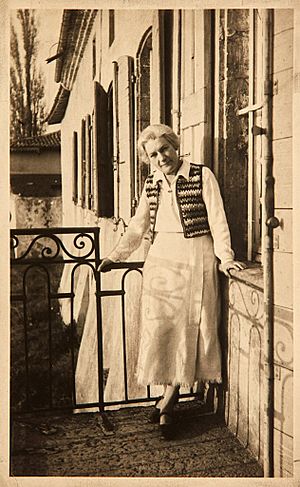Anne Dangar facts for kids
Anne Dangar (born December 1, 1885 – died September 4, 1951) was a talented Australian artist. She was known for her paintings and pottery. Anne Dangar spent much of her life in France, where she explored new art styles. She helped introduce modern art ideas to Australia through her work and letters.
Contents
Life and Art Journey
Anne Dangar was born in Kempsey, a town in New South Wales, Australia. Her father, Otho Orde Dangar, was a member of the Legislative Assembly. This group helps make laws for the state.
Early Training in Sydney
From 1906, Anne studied art in Sydney. She learned from Horace Moore-Jones and at the Julian Ashton Art School. By 1920, she was teaching art there herself. She also worked at a book publishing company called Angus & Robertson.
Discovering Cubism in France
In 1926, Anne Dangar traveled to France with her good friend, Grace Crowley. They studied at André Lhote's Academy in Paris. Here, Anne discovered Cubism, a new art style. Cubism breaks objects into geometric shapes. Artists show these shapes from many angles at once.
When Anne returned to Sydney in 1929, her new cubist style was not very popular. People in Australia were not yet ready for such modern art.
Joining an Artists' Community
So, Anne went back to France in 1930. She joined Moly-Sabata, a special community for artists. It was started by Albert Gleizes, a famous artist. Anne learned a lot from Gleizes's ideas about art.
She also learned pottery from local potters. She worked with them in nearby towns. In 1932, she had her own art show in Annonay, France.
Sharing Ideas Through Letters
Anne Dangar kept in touch with Grace Crowley and other Australian artists. She wrote many letters over 21 years. These letters helped spread ideas about modern art and cubism in Australia. Grace Crowley saved these letters. They are now kept in the Mitchell Library.
Travels and Challenges
Anne's letters also show how hard it was for her to support herself as an artist. In 1939, she traveled to Morocco. She spent six months in Fez, learning from local potters. But she had to leave early because World War II started. She returned to France in 1940.
Anne Dangar lived in Sablons, France, during the war. She decided to stay there after the war ended. She passed away at Moly-Sabata on September 4, 1951, after a stroke. She was buried nearby in Serrières.
Artworks and Collections
Anne Dangar created many important artworks. In 1934, she made a piece called La Vierge et l'enfant Jesu (Virgin and infant Jesus). This artwork is now owned by the Queensland Gallery of Modern Art. It is a great example of "rustic cubism." This is a simpler, more natural version of the cubist style.
Her art can be found in many famous collections. These include the National Gallery of Victoria and the Powerhouse Museum in Australia. Her work is also in major French collections, like the Musée National d'Art Moderne in Paris. The National Gallery of Australia and the Art Gallery of New South Wales hold many of her pieces.
Exhibitions
Anne Dangar's art has been shown in many exhibitions.
Solo Exhibitions
- Anne Dangar at Moly-Sabata: Tradition and Innovation, National Gallery of Australia, 13 Jul-28 Oct 2001.
- Anne Dangar Ceramiste: Le cubism au quotidian, Musee de Valence, 26 Jun 2016-26 Feb 2017.
- Anne Dangar: Ceramics from Moly-Sabata, Art Gallery of New South Wales, 11 Aug-21 Oct 2018.
Group Exhibitions
- Intrepid Women: Australian Women Artists in Paris 1900-1950, S.H. Ervin Gallery, Sydney, 6 Jan-11 Mar 2018.
- Abstraction: Celebrating Australian Women Abstract Artists, National Gallery of Australia touring exhibition, 25 Feb-26 Aug 2017.
- Know My Name: Australian Women Artists 1900 to Now, Part One, National Gallery of Australia, 14 Nov 2020-19 May 2021.
See also
- Andrée Le Coultre


